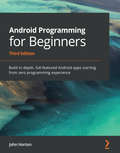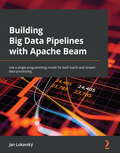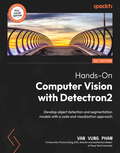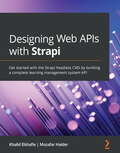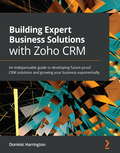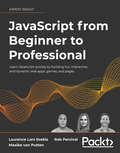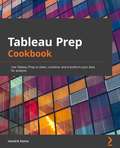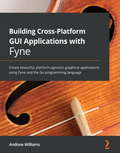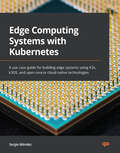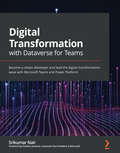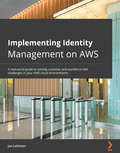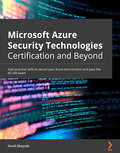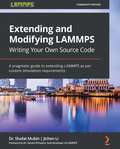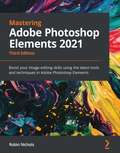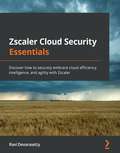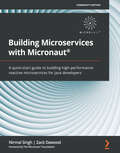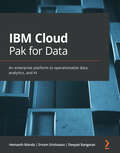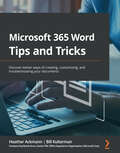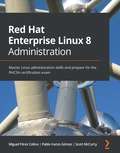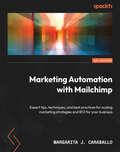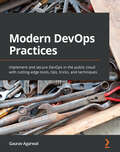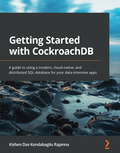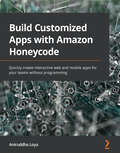- Table View
- List View
Android Programming for Beginners: Build in-depth, full-featured Android apps starting from zero programming experience, 3rd Edition
by John HortonLearn the Java and Android skills you need to start developing powerful mobile applications with the help of actionable stepsKey FeaturesKick-start your Android programming career or just have fun publishing apps to the Google Play marketplaceGet a first principles introduction to using Java and Android and prepare to start building your own apps from scratchLearn by example by building four real-world apps and dozens of mini appsBook DescriptionDo you want to make a career in programming but don't know where to start? Do you have a great idea for an app but don't know how to make it a reality? Or are you worried that you'll have to learn Java programming to become an Android developer? Look no further! This new and expanded third edition of Android Programming for Beginners will be your guide to creating Android applications from scratch. The book starts by introducing you to all the fundamental concepts of programming in an Android context, from the basics of Java to working with the Android API. You'll learn with the help of examples that use up-to-date API classes and are created within Android Studio, the official Android development environment that helps supercharge your mobile application development process. After a crash course on the key programming concepts, you'll explore Android programming and get to grips with creating applications with a professional-standard UI using fragments and storing user data with SQLite. This Android Java book also shows you how you can make your apps multilingual, draw on the screen with a finger, and work with graphics, sound, and animations. By the end of this Android programming book, you'll be ready to start building your own custom applications in Android and Java.What you will learnUnderstand the fundamentals of coding in Java for AndroidInstall and set up your Android development environmentBuild functional user interfaces with the Android Studio visual designerAdd user interaction, data captures, sound, and animation to your appsManage your apps' data using the built-in Android SQLite databaseExplore the design patterns used by professionals to build top-grade applicationsBuild real-world Android applications that you can deploy to the Google Play marketplaceWho this book is forThis Android book is for you if you are completely new to Java, Android, or programming and want to get started with Android app development. If you have experience of using Java on Android, this book will serve as a refresher to help you advance your knowledge and make progress through the early projects covered in the book.
Teaching with Google Classroom: Save time and stay organized while delivering online and in-person classes, 2nd Edition
by Michael ZhangBuild interactive courses for online learning using Google's learning management solutionKey FeaturesDiscover best practices for developing a creative educational experience using the features of Google ClassroomGet to grips with the modern features of Google Classroom that can help you meet the demands of online teachingCreate online courses and deliver classes in an interactive mannerBook DescriptionGoogle Classroom is designed to help you manage and deliver online and in-person courses in an interactive manner. Using Google Classroom saves time organizing and communicating information to students and parents. This updated second edition of Teaching with Google Classroom covers the modern features of Google Classroom that meet the current needs of online teaching. The book is written from the high-school perspective but is applicable to teachers and educators of all age groups. If you're new to Google Classroom or an experienced user who wants to explore more advanced methods with Google Classroom, this book is for you. With hands-on tutorials, projects, and self-assessment questions, you'll learn how to create classes, add students to those classes, send announcements, and assign classwork. The book also demonstrates how to start an online discussion with your students. Later, you'll discover how you can involve parents by inviting them to receive guardian emails and sharing Google Calendar with a URL. This will help them to view assignment deadlines and other important information. The book goes step by step through all the features available and examples of how best to use them to manage your classroom. By the end of this book, you'll be able to do more with Google Classroom, managing your online or in-person school classes effectively.What you will learnCreate a classroom and add customized information for each individual classSend announcements and questions to studentsCreate, distribute, collect, and grade assignments through Google ClassroomLink student accounts to guardian emails for daily or weekly updatesUse Google Forms to create quizzes that automatically grade and return results to studentsReuse posts, archive classrooms, and perform other administrative tasks in Google ClassroomHost online sessions with students and set up Google Classroom's mobile appWho this book is forThis Google Classroom book is written by an educator, for educators. It's for anyone who wants to teach effectively with Google Classroom. There are rich examples, clear instructions, and enlightening explanations to help you put this platform to work.
Forecasting Time Series Data with Facebook Prophet: Build, improve, and optimize time series forecasting models using the advanced forecasting tool
by Greg RaffertyCreate and improve high-quality automated forecasts for time series data that have strong seasonal effects, holidays, and additional regressors using PythonKey FeaturesLearn how to use the open-source forecasting tool Facebook Prophet to improve your forecastsBuild a forecast and run diagnostics to understand forecast qualityFine-tune models to achieve high performance, and report that performance with concrete statisticsBook DescriptionProphet enables Python and R developers to build scalable time series forecasts. This book will help you to implement Prophet's cutting-edge forecasting techniques to model future data with higher accuracy and with very few lines of code. You will begin by exploring the evolution of time series forecasting, from the basic early models to the advanced models of the present day. The book will demonstrate how to install and set up Prophet on your machine and build your first model with only a few lines of code. You'll then cover advanced features such as visualizing your forecasts, adding holidays, seasonality, and trend changepoints, handling outliers, and more, along with understanding why and how to modify each of the default parameters. Later chapters will show you how to optimize more complicated models with hyperparameter tuning and by adding additional regressors to the model. Finally, you'll learn how to run diagnostics to evaluate the performance of your models and see some useful features when running Prophet in production environments. By the end of this Prophet book, you will be able to take a raw time series dataset and build advanced and accurate forecast models with concise, understandable, and repeatable code.What you will learnGain an understanding of time series forecasting, including its history, development, and usesUnderstand how to install Prophet and its dependenciesBuild practical forecasting models from real datasets using PythonUnderstand the Fourier series and learn how it models seasonalityDecide when to use additive and when to use multiplicative seasonalityDiscover how to identify and deal with outliers in time series dataRun diagnostics to evaluate and compare the performance of your modelsWho this book is forThis book is for data scientists, data analysts, machine learning engineers, software engineers, project managers, and business managers who want to build time series forecasts in Python. Working knowledge of Python and a basic understanding of forecasting principles and practices will be useful to apply the concepts covered in this book more easily.
Building Big Data Pipelines with Apache Beam: Use a single programming model for both batch and stream data processing
by Jan LukavskyImplement, run, operate, and test data processing pipelines using Apache BeamKey FeaturesUnderstand how to improve usability and productivity when implementing Beam pipelinesLearn how to use stateful processing to implement complex use cases using Apache BeamImplement, test, and run Apache Beam pipelines with the help of expert tips and techniquesBook DescriptionApache Beam is an open source unified programming model for implementing and executing data processing pipelines, including Extract, Transform, and Load (ETL), batch, and stream processing.This book will help you to confidently build data processing pipelines with Apache Beam. You'll start with an overview of Apache Beam and understand how to use it to implement basic pipelines. You'll also learn how to test and run the pipelines efficiently. As you progress, you'll explore how to structure your code for reusability and also use various Domain Specific Languages (DSLs). Later chapters will show you how to use schemas and query your data using (streaming) SQL. Finally, you'll understand advanced Apache Beam concepts, such as implementing your own I/O connectors.By the end of this book, you'll have gained a deep understanding of the Apache Beam model and be able to apply it to solve problems.What you will learnUnderstand the core concepts and architecture of Apache BeamImplement stateless and stateful data processing pipelinesUse state and timers for processing real-time event processingStructure your code for reusabilityUse streaming SQL to process real-time data for increasing productivity and data accessibilityRun a pipeline using a portable runner and implement data processing using the Apache Beam Python SDKImplement Apache Beam I/O connectors using the Splittable DoFn APIWho this book is forThis book is for data engineers, data scientists, and data analysts who want to learn how Apache Beam works. Intermediate-level knowledge of the Java programming language is assumed.
Hands-On Computer Vision with Detectron2: Develop object detection and segmentation models with a code and visualization approach
by Van Vung Pham Tommy DangExplore Detectron2 using cutting-edge models and learn all about implementing future computer vision applications in custom domainsPurchase of the print or Kindle book includes a free PDF eBookKey FeaturesLearn how to tackle common computer vision tasks in modern businesses with Detectron2Leverage Detectron2 performance tuning techniques to control the model's finest detailsDeploy Detectron2 models into production and develop Detectron2 models for mobile devicesBook DescriptionComputer vision is a crucial component of many modern businesses, including automobiles, robotics, and manufacturing, and its market is growing rapidly. This book helps you explore Detectron2, Facebook's next-gen library providing cutting-edge detection and segmentation algorithms. It's used in research and practical projects at Facebook to support computer vision tasks, and its models can be exported to TorchScript or ONNX for deployment.The book provides you with step-by-step guidance on using existing models in Detectron2 for computer vision tasks (object detection, instance segmentation, key-point detection, semantic detection, and panoptic segmentation). You'll get to grips with the theories and visualizations of Detectron2's architecture and learn how each module in Detectron2 works. As you advance, you'll build your practical skills by working on two real-life projects (preparing data, training models, fine-tuning models, and deployments) for object detection and instance segmentation tasks using Detectron2. Finally, you'll deploy Detectron2 models into production and develop Detectron2 applications for mobile devices.By the end of this deep learning book, you'll have gained sound theoretical knowledge and useful hands-on skills to help you solve advanced computer vision tasks using Detectron2.What you will learnBuild computer vision applications using existing models in Detectron2Grasp the concepts underlying Detectron2's architecture and componentsDevelop real-life projects for object detection and object segmentation using Detectron2Improve model accuracy using Detectron2's performance-tuning techniquesDeploy Detectron2 models into server environments with easeDevelop and deploy Detectron2 models into browser and mobile environmentsWho this book is forIf you are a deep learning application developer, researcher, or software developer with some prior knowledge about deep learning, this book is for you to get started and develop deep learning models for computer vision applications. Even if you are an expert in computer vision and curious about the features of Detectron2, or you would like to learn some cutting-edge deep learning design patterns, you will find this book helpful. Some HTML, Android, and C++ programming skills are advantageous if you want to deploy computer vision applications using these platforms.
Designing Web APIs with Strapi: Get started with the Strapi headless CMS by building a complete learning management system API
by Khalid Elshafie Mozafar HaiderLeverage the power of Strapi to build self-hosted, customizable, and performant content APIsKey FeaturesDiscover how Strapi can help you build APIs quickly and focus on your products and featuresLearn how to put Strapi into practice by implementing it in real-world scenariosUnderstand how to use Strapi's powerful features to customize your APIsBook DescriptionStrapi is a Node.js-based, flexible, open-source headless CMS with an integrated admin panel that anyone can use and helps save API development time. APIs built with Strapi can be consumed using REST or GraphQL from any client. With this book, you'll take a hands-on approach to exploring the capabilities of the Strapi platform and creating a custom API from scratch.This book will help JavaScript developers to put their knowledge to work by guiding them through building powerful backend APIs. You'll see how to effortlessly create content structures that can be customized according to your needs, and gain insights into how to write, edit, and manage your content seamlessly with Strapi. As you progress through the chapters, you'll discover a wide range of Strapi features, as well as understand how to add complex features to the API such as user authentication, data sorting, and pagination. You'll not only learn how to find and use existing plugins from the open-source community but also build your own plugins with custom functionality with the Strapi plugin API and add them to the admin panel. Finally, you'll learn how to deploy the API to Heroku and AWS.By the end of this book, you'll be able to build powerful, scalable, and secure APIs using Strapi.What you will learnExplore Strapi and understand how it worksDefine content types to build APIs quickly and efficientlyUnderstand authentication and authorization in StrapiCreate production-ready APIs with StrapiDeploy the Strapi API to various environments, including Heroku and AWSUse best practices to run the Strapi API in productionSync permissions to access the API between multiple environmentsWrite basic tests for API utilities as well as the endpointWho this book is forThis book is for backend and frontend JavaScript developers. Experienced API developers will learn a new, fast, and flexible way of building APIs, while frontend developers will be able to take a step toward becoming full-stack developers by learning how to leverage Strapi for building APIs quickly. Basic knowledge of JavaScript and REST API concepts is assumed.
Building Expert Business Solutions with Zoho CRM: An indispensable guide to developing future-proof CRM solutions and growing your business exponentially
by Dominic HarringtonCreate world-class Zoho CRM solutions tailored to be a game changer for your business and transform the way you collect, manage, and use customer dataKey FeaturesUnlock the full potential of advanced Zoho CRM features to supercharge your business solutionsCustomize your Zoho CRM solutions to achieve scalable and long-term customer engagementStreamline your entire business for digital transformation by integrating CRM with different Zoho products and applicationsBook DescriptionZoho CRM is one of the most user-friendly, configurable, and competitively priced CRM systems for managing all your customer relationships. When tailored effectively to your business, it empowers your team to work smarter and helps your business to achieve more profitable and scalable growth. This book will show you how to make the most of Zoho CRM to increase productivity. You'll start by learning about the foundation modules of Zoho CRM such as Leads, Deals, Contacts, and Accounts, and understand their functionalities that enable you to build effective solutions. Then, you'll explore innovative workflows that will help you to save time and make sure that your sales teams are proactively managing opportunities and clients. The book also focuses on Zoho Marketplace, as well as how to extend the functionality of Zoho CRM using custom functions. You'll cover real-world use cases that will inspire you to extend your Zoho adoption by integrating Zoho CRM with other Zoho apps such as Zoho Campaigns, Zoho Forms, Zoho Survey, and SalesIQ. Finally, you'll discover best practices for adapting and evolving your CRM solutions and maintaining your CRM to achieve continuous improvement. By the end of this CRM book, you'll have set up a CRM solution that will be fit for the next 10 years of business growth.What you will learnManage customer relationships and acquire new customers quicklyUnderstand the importance of Leads, Deals, Contacts, and Accounts modulesUse game-changing workflows and automation to manage opportunities and clientsExplore how custom functions can extend the functionality of your CRMIntegrate Zoho CRM with other Zoho apps such as Zoho Campaigns, Forms, Survey, and CreatorDiscover how to keep your CRM fit for the future and achieve continuous growthWho this book is forThis book is for you if you're a business manager or a business owner interested in learning how the Zoho platform can help transform your business and are looking to gain a practical understanding of how to choose an app from the vast array of Zoho products. Whether you're new to Zoho or have basic experience and want to learn more about its features and apps, this book can help you. Expert Zoho users who want to develop custom solutions for their business will also find this book useful. Foundational knowledge of CRM concepts is expected to get the most out of this book.
JavaScript from Beginner to Professional: Learn JavaScript quickly by building fun, interactive, and dynamic web apps, games, and pages
by Rob Percival Laurence Lars Svekis Maaike van PuttenStart your journey towards becoming a JavaScript developer with the help of more than 100 fun exercises and projectsKey FeaturesWrite eloquent JavaScript and employ fundamental and advanced features to create your own web appsInteract with the browser with HTML and JavaScript, and add dynamic images, shapes, and text with HTML5 CanvasBuild a password checker, paint web app, hangman game, and many more fun projectsBook DescriptionThis book demonstrates the capabilities of JavaScript for web application development by combining theoretical learning with code exercises and fun projects that you can challenge yourself with. The guiding principle of the book is to show how straightforward JavaScript techniques can be used to make web apps ranging from dynamic websites to simple browser-based games.JavaScript from Beginner to Professional focuses on key programming concepts and Document Object Model manipulations that are used to solve common problems in professional web applications. These include data validation, manipulating the appearance of web pages, working with asynchronous and concurrent code.The book uses project-based learning to provide context for the theoretical components in a series of code examples that can be used as modules of an application, such as input validators, games, and simple animations. This will be supplemented with a brief crash course on HTML and CSS to illustrate how JavaScript components fit into a complete web application.As you learn the concepts, you can try them in your own editor or browser console to get a solid understanding of how they work and what they do. By the end of this JavaScript book, you will feel confident writing core JavaScript code and be equipped to progress to more advanced libraries, frameworks, and environments such as React, Angular, and Node.js.What you will learnUse logic statements to make decisions within your codeSave time with JavaScript loops by avoiding writing the same code repeatedlyUse JavaScript functions and methods to selectively execute codeConnect to HTML5 elements and bring your own web pages to life with interactive contentMake your search patterns more effective with regular expressionsExplore concurrency and asynchronous programming to process events efficiently and improve performanceGet a head start on your next steps with primers on key libraries, frameworks, and APIsWho this book is forThis book is for people who are new to JavaScript (JS) or those looking to build up their skills in web development. Basic familiarity with HTML & CSS would be beneficial.Whether you are a junior or intermediate developer who needs an easy-to-understand practical guide for JS concepts, a developer who wants to transition into working with JS, or a student studying programming concepts using JS, this book will prove helpful.
Tableau Prep Cookbook: Use Tableau Prep to clean, combine, and transform your data for analysis
by Hendrik KleineExplore common and not-so-common data transformation scenarios and solutions to become well-versed with Tableau Prep and create efficient and powerful data pipelinesKey FeaturesCombine, clean, and shape data for analysis using self-service data preparation techniquesBecome proficient with Tableau Prep for building and managing data flows across your organizationLearn how to combine multiple data transformations in order to build a robust datasetBook DescriptionTableau Prep is a tool in the Tableau software suite, created specifically to develop data pipelines. This book will describe, in detail, a variety of scenarios that you can apply in your environment for developing, publishing, and maintaining complex Extract, Transform and Load (ETL) data pipelines. The book starts by showing you how to set up Tableau Prep Builder. You'll learn how to obtain data from various data sources, including files, databases, and Tableau Extracts. Next, the book demonstrates how to perform data cleaning and data aggregation in Tableau Prep Builder. You'll also gain an understanding of Tableau Prep Builder and how you can leverage it to create data pipelines that prepare your data for downstream analytics processes, including reporting and dashboard creation in Tableau. As part of a Tableau Prep flow, you'll also explore how to use R and Python to implement data science components inside a data pipeline. In the final chapter, you'll apply the knowledge you've gained to build two use cases from scratch, including a data flow for a retail store to prepare a robust dataset using multiple disparate sources and a data flow for a call center to perform ad hoc data analysis. By the end of this book, you'll be able to create, run, and publish Tableau Prep flows and implement solutions to common problems in data pipelines.What you will learnPerform data cleaning and preparation techniques for advanced data analysisUnderstand how to combine multiple disparate datasetsPrepare data for different Business Intelligence (BI) toolsApply Tableau Prep's calculation language to create powerful calculationsUse Tableau Prep for ad hoc data analysis and data science flowsDeploy Tableau Prep flows to Tableau Server and Tableau OnlineWho this book is forThis book is for business intelligence professionals, data analysts, and Tableau users looking to learn Tableau Prep essentials and create data pipelines or ETL processes using it. Beginner-level knowledge of data management will be beneficial to understand the concepts covered in this Tableau cookbook more effectively.
Building Cross-Platform GUI Applications with Fyne: Create beautiful, platform-agnostic graphical applications using Fyne and the Go programming language
by Andrew WilliamsUnderstand how to use the Fyne toolkit to build exciting apps for a range of devices and deploy them effectivelyKey FeaturesLearn how to use standard widgets, dialogs, and layouts as well as how to build your ownUnderstand how to develop an app and package and distribute it to different operating systems and app storesExplore the design principles and vision of the Fyne toolkit and how that may align with your projectBook DescriptionThe history of graphical application development is long and complicated, with various development challenges that persist to this day. The mix of technologies involved and the need to use different programming languages led to a very steep learning curve for developers looking to build applications across multiple platforms. In Building Cross-Platform GUI Applications with Fyne, you'll understand how the Go language, when paired with a modern graphical toolkit such as Fyne, can overcome these issues and make application development much easier. To provide an easy-to-use framework for cross-platform app development, the Fyne project offers many graphical concepts and design principles that are outlined throughout this book. By working through five example projects, you'll learn how to build apps effectively, focusing on each of the main areas, including the canvas, layouts, file handling, widgets, data binding, and themes. The book will also show you how the completed applications can then be run on your desktop computer, laptop, and smartphone. After completing these projects, you will discover how to prepare applications for release and distribute them to platform marketplaces and app stores. By the end of this book, you'll be able to create cross-platform graphical applications with visually appealing user interfaces and concise code.What you will learnBecome well-versed with the history of GUI development and how Fyne and the Golang programming language make it easierExplore how the Fyne toolkit is architected and the various modules are providedDiscover how Fyne apps can be tested and constructed using best practicesConstruct five complete applications and deploy them to your devicesCustomize the design of your apps by extending widgets and themesUnderstand the separation and presentation of data and how to test and build applications that present dynamic dataWho this book is forThis Fyne-Golang GUI book is for developers from any background who are looking to build cross-platform applications with a modern toolkit. It will also be useful for Go developers who are looking to explore graphical apps and GUI developers looking for a new toolkit for cross-platform development. Basic knowledge of Graphical User Interface (GUI) development is assumed (although a brief history is also included in the book). The book also features a short introduction to the Go language as a quick refresher.
Edge Computing Systems with Kubernetes: A use case guide for building edge systems using K3s, k3OS, and open source cloud native technologies
by Sergio MendezUnderstand how to use K3s and k3OS for different use cases and discover best practices for building an edge computing systemKey FeaturesA guide to implementing an edge computing environmentReduce latency and costs for real-time applications running at the edgeFind stable and relevant cloud native open source software to complement your edge environmentsBook DescriptionEdge computing is a way of processing information near the source of data instead of processing it on data centers in the cloud. In this way, edge computing can reduce latency when data is processed, improving the user experience on real-time data visualization for your applications. Using K3s, a light-weight Kubernetes and k3OS, a K3s-based Linux distribution along with other open source cloud native technologies, you can build reliable edge computing systems without spending a lot of money.In this book, you will learn how to design edge computing systems with containers and edge devices using sensors, GPS modules, WiFi, LoRa communication and so on. You will also get to grips with different use cases and examples covered in this book, how to solve common use cases for edge computing such as updating your applications using GitOps, reading data from sensors and storing it on SQL and NoSQL databases. Later chapters will show you how to connect hardware to your edge clusters, predict using machine learning, and analyze images with computer vision. All the examples and use cases in this book are designed to run on devices using 64-bit ARM processors, using Raspberry Pi devices as an example.By the end of this book, you will be able to build your own edge computing systems using the content of the chapters as Lego pieces to fit your needs.What you will learnConfigure k3OS and K3s for development and production scenariosPackage applications into K3s for shipped-node scenariosDeploy in occasionally connected scenarios, from one node to one million nodesManage GitOps for applications across different locationsUse open source cloud native software to complement your edge computing systemsImplement observability event-driven and serverless edge applicationsCollect and process data from sensors at the edge and visualize it into the cloudWho this book is forThis book is for engineers (developers and/or operators) seeking to bring the cloud native benefits of GitOps and Kubernetes to the edge. Anyone with basic knowledge of Linux and containers looking to learn Kubernetes using examples applied to edge computing and hardware systems will benefit from this book.
Digital Transformation with Dataverse for Teams: Become a citizen developer and lead the digital transformation wave with Microsoft Teams and Power Platform
by Srikumar Nair Charles LamannaDesign, build, and deploy multi-platform apps to overcome crucial business problems by leveraging the capabilities of low-code and no-code development enabled through Microsoft Power Platform and TeamsKey FeaturesFind out how you can accelerate the digital transformation of your organization as a citizen developerBuild your first app with the help of step-by-step guidance and add capabilities with flows and botsLearn about lifecycle management for applications, environments, and licensingBook DescriptionMicrosoft Dataverse for Teams is a built-in, low-code data platform for Teams and enables everyone to easily build and deploy apps, flows, and intelligent chatbots using Power Apps, Power Automate, and Power Virtual Agents (PVA) embedded in Microsoft Teams. Without learning any coding language, you will be able to build apps with step-by-step explanations for setting up Teams, creating tables to store data, and leverage the data for your digital solutions. With the techniques covered in the book, you'll be able to develop your first app with Dataverse for Teams within an hour! You'll then learn how to automate repetitive tasks or build alerts using Power Automate and Power Virtual Agents. As you get to grips with building these digital solutions, you'll also be able to understand when to consider upgrading from Dataverse for Teams to Dataverse, along with its advanced features. Finally, you'll explore features for administration and governance and understand the licensing requirements of Microsoft Dataverse for Teams and PowerApps. Having acquired the skills to build and deploy an enterprise-grade digital solution, by the end of the book, you will have become a qualified citizen developer and be ready to lead a digital revolution in your organization.What you will learnGain a deeper understanding of Microsoft Dataverse for Teams by exploring various business scenariosDesign, build, and deploy enterprise-grade applications for TeamsDevelop Power Automate flows and PVA bots using Dataverse for TeamsDiscover administration and security best practicesUnderstand the licensing requirements and advanced features of Microsoft DataverseIdentify scenarios in your organizations where your citizen development skills can be leveragedWho this book is forThe book is for citizen developers, business professionals, or anyone looking to develop applications to solve critical business problems. Basic knowledge of using software like PowerPoint, Excel-like formulae, and navigating between application screens is all you need to get started with this book.
Implementing Identity Management on AWS: A real-world guide to solving customer and workforce IAM challenges in your AWS cloud environments
by Jon Lehtinen Steve "Hutch" HutchinsonUnderstand the IAM toolsets, capabilities, and paradigms of the AWS platform and learn how to apply practical identity use cases to AWS at the administrative and application levelKey FeaturesLearn administrative lifecycle management and authorizationExtend workforce identity to AWS for applications deployed to Amazon Web Services (AWS)Understand how to use native AWS IAM capabilities with apps deployed to AWSBook DescriptionAWS identity management offers a powerful yet complex array of native capabilities and connections to existing enterprise identity systems for administrative and application identity use cases. This book breaks down the complexities involved by adopting a use-case-driven approach that helps identity and cloud engineers understand how to use the right mix of native AWS capabilities and external IAM components to achieve the business and security outcomes they want.You will begin by learning about the IAM toolsets and paradigms within AWS. This will allow you to determine how to best leverage them for administrative control, extending workforce identities to the cloud, and using IAM toolsets and paradigms on an app deployed on AWS. Next, the book demonstrates how to extend your on-premise administrative IAM capabilities to the AWS backplane, as well as how to make your workforce identities available for AWS-deployed applications. In the concluding chapters, you'll learn how to use the native identity services with applications deployed on AWS.By the end of this IAM Amazon Web Services book, you will be able to build enterprise-class solutions for administrative and application identity using AWS IAM tools and external identity systems.What you will learnUnderstand AWS IAM concepts, terminology, and servicesExplore AWS IAM, Amazon Cognito, AWS SSO, and AWS Directory Service to solve customer and workforce identity problemsApply the concepts you learn about to solve business, process, and compliance challenges when expanding into AWSNavigate the AWS CLI to unlock the programmatic administration of AWSExplore how AWS IAM, its policy objects, and notational language can be applied to solve security and access management use casesRelate concepts easily to your own environment through IAM patterns and best practicesWho this book is forIdentity engineers and administrators, cloud administrators, security architects, or anyone who wants to explore and manage IAM solutions in AWS will find this book useful. Basic knowledge of AWS cloud infrastructure and services is required to understand the concepts covered in the book more effectively.
Microsoft Azure Security Technologies Certification and Beyond: Gain practical skills to secure your Azure environment and pass the AZ-500 exam
by David OkeyodeLearn how to implement multi-layered security controls to protect against rapidly evolving threats to Azure environmentsKey FeaturesDevelop practical skills to protect your organization from constantly evolving security threatsBecome well-versed with real-world Azure security strategies and AZ-500 exam objectivesEffectively manage security governance, policies, and operations in AzureBook DescriptionSecurity is a key part of any well-architected design. With the help of this book, you'll gain both the knowledge and the practical skills to significantly reduce the attack surface of your Azure workloads and protect your organization from constantly evolving threats to public cloud environments like Azure.This book is a comprehensive security guide for those looking to take the Azure Security Engineer certification exam as well as for those interested in securing their Azure infrastructure. Beyond preparing you for the Azure Security (AZ-500) exam, this book will guide you in securing your Azure environments and workloads using native Azure security capabilities.Complete with hands-on tutorials, projects, and self-assessment questions, this easy-to-follow guide builds a solid foundation of Azure security. You'll not only learn about security technologies in Azure but also be able to configure and manage them. Moreover, you'll develop a clear understanding of how to identify different attack vectors and mitigate risks.By the end of this book, you'll be well-versed with implementing multi-layered security to protect identities, networks, hosts, containers, databases, and storage in Azure.What you will learnManage users, groups, service principals, and roles effectively in Azure ADExplore Azure AD identity security and governance capabilitiesUnderstand how platform perimeter protection secures Azure workloadsImplement network security best practices for IaaS and PaaSDiscover various options to protect against DDoS attacksSecure hosts and containers against evolving security threatsConfigure platform governance with cloud-native toolsMonitor security operations with Azure Security Center and Azure SentinelWho this book is forIf you are a newly qualified or experienced security professional, cloud administrator, architect, or developer who wants to understand how to secure your Azure environment and workloads, this book is for you. The book is a handy resource for anyone preparing to take the Azure Security Engineer (AZ-500) certification exam. Foundational knowledge of the Azure cloud platform will be helpful but not necessary to understand the concepts covered in this book.
Extending and Modifying LAMMPS Writing Your Own Source Code: A pragmatic guide to extending LAMMPS as per custom simulation requirements
by Dr. Shafat Mubin Jichen Li Dr. Steven PlimptonUnderstand the LAMMPS source code and modify it to meet your research needs, and run simulations for bespoke applications involving forces, thermostats, pair potentials and more with easeKey FeaturesUnderstand the structure of the LAMMPS source codeImplement custom features in the LAMMPS source code to meet your research needsRun example simulations involving forces, thermostats, and pair potentials based on implemented featuresBook DescriptionLAMMPS is one of the most widely used tools for running simulations for research in molecular dynamics. While the tool itself is fairly easy to use, more often than not you'll need to customize it to meet your specific simulation requirements. Extending and Modifying LAMMPS bridges this learning gap and helps you achieve this by writing custom code to add new features to LAMMPS source code. Written by ardent supporters of LAMMPS, this practical guide will enable you to extend the capabilities of LAMMPS with the help of step-by-step explanations of essential concepts, practical examples, and self-assessment questions. This LAMMPS book provides a hands-on approach to implementing associated methodologies that will get you up and running and productive in no time. You'll begin with a short introduction to the internal mechanisms of LAMMPS, and gradually transition to an overview of the source code along with a tutorial on modifying it. As you advance, you'll understand the structure, syntax, and organization of LAMMPS source code, and be able to write your own source code extensions to LAMMPS that implement features beyond the ones available in standard downloadable versions. By the end of this book, you'll have learned how to add your own extensions and modifications to the LAMMPS source code that can implement features that suit your simulation requirements.What you will learnIdentify how LAMMPS input script commands are parsed within the source codeUnderstand the architecture of the source codeRelate source code elements to simulated quantitiesLearn how stored quantities are accessed within the source codeExplore the mechanisms controlling pair styles, computes, and fixesModify the source code to implement custom features in LAMMPSWho this book is forThis book is for students, faculty members, and researchers who are currently using LAMMPS or considering switching to LAMMPS, have a basic knowledge of how to use LAMMPS, and are looking to extend LAMMPS source code for research purposes. This book is not a tutorial on using LAMMPS or writing LAMMPS scripts, and it is assumed that the reader is comfortable with the basic LAMMPS syntax. The book is geared toward users with little to no experience in source code editing. Familiarity with C++ programming is helpful but not necessary.
Mastering Adobe Photoshop Elements 2021: Boost your image-editing skills using the latest tools and techniques in Adobe Photoshop Elements, 3rd Edition
by Robin NicholsLeverage this well-illustrated, easy-to-understand end-to-end guide to become an accomplished photo editor, image retoucher, and creative artistKey FeaturesUpdated to the latest version of Photoshop Elements 2021 with focused coverage of Adobe's latest AI technologyOrganize, search, and manage an ever-increasing number of images and videos using expert practicesUncover common solutions to a wide range of photographic and image-editing problemsBook DescriptionManaging thousands of images while producing perfectly edited results is now a must-have skill for online bloggers, influencers, vloggers, social media users, and photography enthusiasts. Photoshop Elements helps you to manage this easily and boost your creative output. This third edition is updated with Elements 2021's latest features and focuses on Adobe's AI-powered features along with the entire creative workflow. Each chapter is designed to help you get the most out of your image files in an easy way. You'll learn how to add significant visual improvements to your work using no more than a few one-click edits with AI-driven features and manual adjustments. The book is filled with useful instructions to guide you seamlessly through the often complex processes, tools, and features in Photoshop Elements. Finally, you'll cover everything from developing your organizational skills through to creating remarkable special effects, complex text, image combinations, and eye-popping visual techniques using both AI-driven features as well as manually operated tools. By the end of this Photoshop Elements book, you'll have learned how to leverage the impressive tools available in Photoshop Elements 2021, and use them to greatly improve your photo editing and image retouching skills.What you will learnIdentify the five parts of Elements and set up your computer, camera, and monitorImport, organize, and keep track of your imported media libraryDevelop advanced image retouching skillsDiscover how to add text and graphics to photographsCultivate your understanding of multi-image, multi-layered editing techniquesDevelop illustrative skills with the many drawing tools available in Elements 2021Prepare images and projects for uploading to social media, print, and videoFind out how to troubleshoot your work when things don't come out the way you hoped they wouldWho this book is forThis book is for amateur photographers looking to dip their toes into the editing world, anyone who wants simple but effective ideas on how to expand their creativity, as well as advanced enthusiasts seeking to push the boundaries of their creative output. Though not necessary, photography skills together with basic photo editing knowledge will help you to get the most out of this book.
Zscaler Cloud Security Essentials: Discover how to securely embrace cloud efficiency, intelligence, and agility with Zscaler
by Ravi DevarasettyHarness the capabilities of Zscaler to deliver a secure, cloud-based, scalable web proxy and provide a zero-trust network access solution for private enterprise application access to end usersKey FeaturesGet up to speed with Zscaler without the need for expensive trainingImplement Zscaler Internet Access (ZIA) and Zscaler Private Access (ZPA) security solutions with real-world deploymentsFind out how to choose the right options and features to architect a customized solution with ZscalerBook DescriptionMany organizations are moving away from on-premises solutions to simplify administration and reduce expensive hardware upgrades. This book uses real-world examples of deployments to help you explore Zscaler, an information security platform that offers cloud-based security for both web traffic and private enterprise applications. You'll start by understanding how Zscaler was born in the cloud, how it evolved into a mature product, and how it continues to do so with the addition of sophisticated features that are necessary to stay ahead in today's corporate environment. The book then covers Zscaler Internet Access and Zscaler Private Access architectures in detail, before moving on to show you how to map future security requirements to ZIA features and transition your business applications to ZPA. As you make progress, you'll get to grips with all the essential features needed to architect a customized security solution and support it. Finally, you'll find out how to troubleshoot the newly implemented ZIA and ZPA solutions and make them work efficiently for your enterprise. By the end of this Zscaler book, you'll have developed the skills to design, deploy, implement, and support a customized Zscaler security solution. What you will learnUnderstand the need for Zscaler in the modern enterpriseStudy the fundamental architecture of the Zscaler cloudGet to grips with the essential features of ZIA and ZPAFind out how to architect a Zscaler solutionDiscover best practices for deploying and implementing Zscaler solutionsFamiliarize yourself with the tasks involved in the operational maintenance of the Zscaler solutionWho this book is forThis book is for security engineers, security architects, security managers, and security operations specialists who may be involved in transitioning to or from Zscaler or want to learn about deployment, implementation, and support of a Zscaler solution. Anyone looking to step into the ever-expanding world of zero-trust network access using the Zscaler solution will also find this book useful.
Building Microservices with Micronaut®: A quick-start guide to building high-performance reactive microservices for Java developers
by Nirmal Singh Zack Dawood A23 The Micronaut® FoundationExplore different aspects of building modular microservices such as development, testing, maintenance, and deployment using the Micronaut frameworkKey FeaturesLearn how to build scalable, fast, and resilient microservices with this concise guideExplore the many advantages of using reflection-free, compile-time dependency injections and aspect-oriented programmingBuild cloud-native applications easily with the Micronaut frameworkBook DescriptionThe Micronaut® open source software is a JVM-based framework, designed to create microservices quickly and easily. This book will help full-stack and Java developers to build modular, high-performing, and reactive microservice-based apps using Micronaut. You'll start by building microservices and learning about the core components of Micronaut, such as ahead-of-time compilation, reflection-less dependency injection, and reactive baked-in HTTP clients and servers. Next, you will work on a real-time microservice application and learn how to integrate Micronaut with different kinds of relational and non-relational databases. You'll also learn how to employ different security mechanisms to safeguard your microservices and integrate microservices using event-driven architecture in the Apache Kafka ecosystem. As you advance, you'll get to grips with automated testing and popular testing tools. The book will help you understand how you can easily handle microservice concerns in the Micronaut framework, such as service discovery, API documentation, distributed configuration management, fallbacks, and circuit breakers. Finally, you'll explore the deployment and maintenance aspects of microservices and get up to speed with the Internet of Things (IoT) using Micronaut. By the end of this book, you'll be able to build, test, deploy, and maintain your own microservice apps using Micronaut.What you will learnUnderstand why Micronaut is best suited for building microservicesBuild web endpoints and services in the Micronaut frameworkSafeguard microservices using Session, JWT, and OAuth in MicronautGet to grips with event-driven architecture in MicronautDiscover how to automate testing at various levels using built-in tools and testing frameworksDeploy your microservices to containers and cloud platformsBecome well-versed with distributed logging, tracing, and monitoring in MicronautGet hands-on with the IoT using Alexa and MicronautWho this book is forThis book is for developers who have been building microservices on traditional frameworks such as Spring Boot and are looking for a faster alternative. Intermediate-level knowledge of Java programming and implementing web services development in Java is required.
IBM Cloud Pak for Data: An enterprise platform to operationalize data, analytics, and AI
by Hemanth Manda Sriram Srinivasan Deepak RangaraoBuild end-to-end AI solutions with IBM Cloud Pak for Data to operationalize AI on a secure platform based on cloud-native reliability, cost-effective multitenancy, and efficient resource managementKey FeaturesExplore data virtualization by accessing data in real time without moving itUnify the data and AI experience with the integrated end-to-end platformExplore the AI life cycle and learn to build, experiment, and operationalize trusted AI at scaleBook DescriptionCloud Pak for Data is IBM's modern data and AI platform that includes strategic offerings from its data and AI portfolio delivered in a cloud-native fashion with the flexibility of deployment on any cloud. The platform offers a unique approach to addressing modern challenges with an integrated mix of proprietary, open-source, and third-party services. You'll begin by getting to grips with key concepts in modern data management and artificial intelligence (AI), reviewing real-life use cases, and developing an appreciation of the AI Ladder principle. Once you've gotten to grips with the basics, you will explore how Cloud Pak for Data helps in the elegant implementation of the AI Ladder practice to collect, organize, analyze, and infuse data and trustworthy AI across your business. As you advance, you'll discover the capabilities of the platform and extension services, including how they are packaged and priced. With the help of examples present throughout the book, you will gain a deep understanding of the platform, from its rich capabilities and technical architecture to its ecosystem and key go-to-market aspects. By the end of this IBM book, you'll be able to apply IBM Cloud Pak for Data's prescriptive practices and leverage its capabilities to build a trusted data foundation and accelerate AI adoption in your enterprise.What you will learnUnderstand the importance of digital transformations and the role of data and AI platformsGet to grips with data architecture and its relevance in driving AI adoption using IBM's AI LadderUnderstand Cloud Pak for Data, its value proposition, capabilities, and unique differentiatorsDelve into the pricing, packaging, key use cases, and competitors of Cloud Pak for DataUse the Cloud Pak for Data ecosystem with premium IBM and third-party servicesDiscover IBM's vibrant ecosystem of proprietary, open-source, and third-party offerings from over 35 ISVsWho this book is forThis book is for data scientists, data stewards, developers, and data-focused business executives interested in learning about IBM's Cloud Pak for Data. Knowledge of technical concepts related to data science and familiarity with data analytics and AI initiatives at various levels of maturity are required to make the most of this book.
Microsoft 365 Word Tips and Tricks: Discover top features and expert techniques for creating, editing, customizing, and troubleshooting documents
by Heather Ackmann Bill Kulterman Ramit AroraExplore Word's top tools and undiscovered features, and learn how to use them optimally in a business or real-world settingKey FeaturesUse MS Word more efficiently and leverage this handy guide to help you when you get stuckCollaborate online effectively and format a variety of professional documents expertlyHone your MS Word troubleshooting skills to solve formatting problems and issues encountered by everyday usersBook DescriptionMicrosoft Word, or MS Word, is a word processor developed by Microsoft. Although Word is one of the office productivity applications included in the Microsoft Office suite, it can also be purchased as a standalone product. MS Word enables you to create, edit, and save professional documents, among other helpful features. Anyone who wants to get better at working with Word will be able to put their MS Word knowledge to use with this practical guide.The book takes a hands-on problem- and solution-based approach to implementation and provides associated methodologies that will have you up and running and productive in no time. Complete with step-by-step explanations of essential concepts and practical examples, you'll begin by exploring different versions of Microsoft Word and understand how these versions impact collaboration with others, along with exploring the features available. Throughout the book, you'll learn how to work more productively and efficiently, with others as well as by yourself, using Word's sharing and collaboration features and the new reading and accessibility features.By the end of this Microsoft Word book, you will be able to troubleshoot common issues that may arise when working with documents.What you will learnTrack a document's changes as well as comment on and review changes by others, both locally and remotelyUse Word's navigation and view features to improve productivityGenerate more consistently formatted documents with StylesPerform common tasks through simple formatting techniques, Quick Parts, customizing AutoCorrect/AutoFormat, and memorizing keyboard shortcutsTroubleshoot the most frustrating formatting problems experienced by Word usersCreate more universally accessible documents by adding Alt Text using the accessibility checker and other Word featuresWho this book is forThis book is for business professionals with basic experience of Office apps looking to utilize the Windows version of Microsoft Word to create, edit, format, read, print, and collaborate with short and long documents at home, at work, and on the go. The book assumes some very basic knowledge of Word and word processing programs in general, such as open, save, copy, and paste.
Red Hat Enterprise Linux 8 Administration: Master Linux administration skills and prepare for the RHCSA certification exam
by Miguel Perez Colino Pablo Iranzo Gomez Scott McCartyDevelop the skill to manage and administer Red Hat Enterprise Linux and get ready to achieve the RHCSA certificationKey FeaturesLearn the most common administration and security tasks and manage enterprise Linux infrastructures efficientlyAssess your knowledge using self-assessment questions based on real-world examplesUnderstand how to apply the concepts of core systems administration in the real worldBook DescriptionWhether in infrastructure or development, as a DevOps or site reliability engineer, Linux skills are now more relevant than ever for any IT job, forming the foundation of understanding the most basic layer of your architecture. With Red Hat Enterprise Linux (RHEL) becoming the most popular choice for enterprises worldwide, achieving the Red Hat Certified System Administrator (RHCSA) certification will validate your Linux skills to install, configure, and troubleshoot applications and services on RHEL systems.Complete with easy-to-follow tutorial-style content, self-assessment questions, tips, best practices, and practical exercises with detailed solutions, this book covers essential RHEL commands, user and group management, software management, networking fundamentals, and much more. You'll start by learning how to create an RHEL 8 virtual machine and get to grips with essential Linux commands. You'll then understand how to manage users and groups on an RHEL 8 system, install software packages, and configure your network interfaces and firewall. As you advance, the book will help you explore disk partitioning, LVM configuration, Stratis volumes, disk compression with VDO, and container management with Podman, Buildah, and Skopeo.By the end of this book, you'll have covered everything included in the RHCSA EX200 certification and be able to use this book as a handy, on-the-job desktop reference guide.This book and its contents are solely the work of Miguel Perez Colino, Pablo Iranzo Gomez, and Scott McCarty. The content does not reflect the views of their employer (Red Hat Inc.). This work has no connection to Red Hat, Inc. and is not endorsed or supported by Red Hat, Inc.What you will learnDeploy RHEL 8 in different footprints, from bare metal and virtualized to the cloudManage users and software on local and remote systems at scaleDiscover how to secure a system with SELinux, OpenSCAP, and firewalldGain an overview of storage components with LVM, Stratis, and VDOMaster remote administration with passwordless SSH and tunnelsMonitor your systems for resource usage and take actions to fix issuesUnderstand the boot process, performance optimizations, and containersWho this book is forThis book is for IT professionals or students who want to start a career in Linux administration and anyone who wants to take the RHCSA 8 certification exam. Basic knowledge of Linux and familiarity with the Linux command-line is necessary.
Marketing Automation with Mailchimp: Expert tips, techniques, and best practices for scaling marketing strategies and ROI for your business
by Margarita J. CaraballoSet up your first channel and effectively expand your outreach and customer base with Mailchimp to deliver scalable business outcomesPurchase of the print or Kindle book includes a free PDF eBookKey FeaturesLearn audience management strategies to make informed decisions for your marketing channelsEmploy practical use cases for your custom business needs to implement basic and pro Mailchimp featuresCustomize Mailchimp using powerful integrations to deliver top-notch user experienceBook DescriptionAre you looking for an all-in-one comprehensive guide to implementing Mailchimp channels and automation for your business? Then Marketing Automation with Mailchimp can be your go-to guide. You'll start by learning common terms used in the Mailchimp environment, as well as about account setup and audience management for businesses. After that, you'll find out how to set up channels, where you'll actively interact with your contacts and begin to add new ones. Additionally, you'll gain an understanding of how to set up a consistent marketing presence in the form of emails and websites and the benefits of determining a brand identity. You'll also explore advanced Mailchimp features to optimize platform utilization using analytics, reporting, A/B and multivariate testing, the customer journey builder, and the Mailchimp e-commerce store. Toward the end, you'll discover some important shopping, payment, and CRM integrations that can be connected to your Mailchimp platform for custom business needs. With this book, you'll gain insights into real-world use cases to implement a marketing strategy to extend your existing work. By the end of this book, you'll be well-equipped to implement Mailchimp marketing automation seamlessly into your business to grow your customer base and revenue.What you will learnUnderstand specific account-level settings, their purpose, and account managementExplore strategies and tools for managing inactive contacts for target marketingIntegrate Mailchimp for easy customization with a low-code options for customizationEstablish a strong marketing presence with email and websites and leverage it for e-commerce and servicesDiscover advanced reporting and analytics by turning audience information into relevant growth metricsAutomate your marketing workflows using the Mailchimp customer journey builderWho this book is forThis book is for marketing professionals or small-to-midsize business entrepreneurs looking to start a marketing journey through powerful marketing automation. To get the best from this book, you must be familiar with using web apps and have an understanding of content design. This book will help anyone who is looking to start a marketing career and wants to take hands-on ownership of building marketing and outreach strategies for the business.
Modern DevOps Practices: Implement and secure DevOps in the public cloud with cutting-edge tools, tips, tricks, and techniques
by Gaurav AgarwalEnhance DevOps workflows by integrating the functionalities of Docker, Kubernetes, Spinnaker, Ansible, Terraform, Flux CD, CaaS, and more with the help of practical examples and expert tipsKey FeaturesGet up and running with containerization-as-a-service and infrastructure automation in the public cloudLearn container security techniques and secret management with Cloud KMS, Anchore Grype, and Grafeas KritisLeverage the combination of DevOps, GitOps, and automation to continuously ship a package of softwareBook DescriptionContainers have entirely changed how developers and end-users see applications as a whole. With this book, you'll learn all about containers, their architecture and benefits, and how to implement them within your development lifecycle.You'll discover how you can transition from the traditional world of virtual machines and adopt modern ways of using DevOps to ship a package of software continuously. Starting with a quick refresher on the core concepts of containers, you'll move on to study the architectural concepts to implement modern ways of application development. You'll cover topics around Docker, Kubernetes, Ansible, Terraform, Packer, and other similar tools that will help you to build a base. As you advance, the book covers the core elements of cloud integration (AWS ECS, GKE, and other CaaS services), continuous integration, and continuous delivery (GitHub actions, Jenkins, and Spinnaker) to help you understand the essence of container management and delivery. The later sections of the book will take you through container pipeline security and GitOps (Flux CD and Terraform).By the end of this DevOps book, you'll have learned best practices for automating your development lifecycle and making the most of containers, infrastructure automation, and CaaS, and be ready to develop applications using modern tools and techniques.What you will learnBecome well-versed with AWS ECS, Google Cloud Run, and KnativeDiscover how to build and manage secure Docker images efficientlyUnderstand continuous integration with Jenkins on Kubernetes and GitHub actionsGet to grips with using Spinnaker for continuous deployment/deliveryManage immutable infrastructure on the cloud with Packer, Terraform, and AnsibleExplore the world of GitOps with GitHub actions, Terraform, and Flux CDWho this book is forIf you are a software engineer, system administrator, or operations engineer looking to step into the world of DevOps within public cloud platforms, this book is for you. Existing DevOps engineers will also find this book useful as it covers best practices, tips, and tricks to implement DevOps with a cloud-native mindset. Although no containerization experience is necessary, a basic understanding of the software development life cycle and delivery will help you get the most out of the book.
Getting Started with CockroachDB: A guide to using a modern, cloud-native, and distributed SQL database for your data-intensive apps
by Kishen Das RajannaGet hands-on with deploying and managing your database services to provide scalable and high-speed data access on CockroachDBKey FeaturesGain insights into CockroachDB and build highly reliable cloud-native applicationsExplore the power of a scalable and highly available cloud-native SQL database to distribute data and workloads automaticallyBuild high-speed database services using CockroachDB and troubleshoot performance issuesBook DescriptionGetting Started with CockroachDB will introduce you to the inner workings of CockroachDB and help you to understand how it provides faster access to distributed data through a SQL interface. The book will also uncover how you can use the database to provide solutions where the data is highly available.Starting with CockroachDB's installation, setup, and configuration, this SQL book will familiarize you with the database architecture and database design principles. You'll then discover several options that CockroachDB provides to store multiple copies of your data to ensure fast data access. The book covers the internals of CockroachDB, how to deploy and manage it on the cloud, performance tuning to get the best out of CockroachDB, and how to scale data across continents and serve it locally. In addition to this, you'll get to grips with fault tolerance and auto-rebalancing, how indexes work, and the CockroachDB Admin UI. The book will guide you in building scalable cloud services on top of CockroachDB, covering administrative and security aspects and tips for troubleshooting, performance enhancements, and a brief guideline on migrating from traditional databases.By the end of this book, you'll have gained sufficient knowledge to manage your data on CockroachDB and interact with it from your application layer.What you will learnBecome well-versed with the overall architecture and design concepts of CockroachDBUnderstand how auto-rebalancing of data can avoid performance bottlenecksGet to know how CockroachDB achieves atomicity, consistency, isolation, and durabilityPartition your data across multiple geolocations to ensure very low latency when serving dataFind out how indexes are stored and the optimizations used to serve query results fasterDiscover the key concepts of deploying and managing CockroachDB clustersWho this book is forSoftware engineers, database developers, database administrators, and anyone who wishes to learn about the features of CockroachDB and how to build database solutions that are fast, highly available, and cater to business-critical applications, will find this book useful. Although no prior exposure to CockroachDB is required, familiarity with database concepts will help you to get the most out of this book.
Build Customized Apps with Amazon Honeycode: Quickly create interactive web and mobile apps for your teams without programming
by Aniruddha LoyaA non-developer's guide to harnessing the power of Amazon Honeycode apps to manage projects, customers, operations, approvals, resources, and teamsKey FeaturesA practical guide to Amazon Web Services (AWS) no-code app development for meeting specific needs of customersCreate apps quickly without paying for costly developers using Honeycode's in-built templates and functionsLearn how to use stable AWS services to supplement Honeycode's present limitsBook DescriptionAmazon Honeycode enables you to build fully managed, customizable, and scalable mobile and web applications for personal or professional use with little to no code. With this practical guide to Amazon Honeycode, you'll be able to bring your app ideas to life, improving your and your team's/organization's productivity. You'll begin by creating your very first app from the get-go and use it as a means to explore the Honeycode development environment and concepts. Next, you'll learn how to set up and organize the data to build and bind an app on Honeycode as well as deconstruct different templates to understand the common structures and patterns that can be used. Finally, you'll build a few apps from scratch and discover how to apply the concepts you've learned. By the end of this app development book, you'll have gained the knowledge you need to be able to build and deploy your own mobile and web applications. You'll also be able to invite and share your app with people you want to collaborate with.What you will learnBuild mobile and web applications with simple drag-drops and customizationsDeploy and share apps and collaborate in real-time with your teamUnderstand how to create automated processes in appsCreate a customized view for each app user or a group of usersImport existing data from a CSV and build an app on top of itCreate connectors to external data sourcesBuild applications using Honeycode either from scratch or by modifying an existing templateExplore Honeycode templates and understand what use cases are available out-of-the-box with these templatesWho this book is forLike the platform, this book is meant for everyone - professional and novice developers alike - who want to build and deploy apps for their personal or professional use as an individual or as a team. However, for professional developers, it is important to note that the book will not focus on advanced use cases with features like using public APIs and 3P integrations. No programming knowledge or experience is needed to start creating basic apps. However, working knowledge of Microsoft Excel or similar spreadsheet tools and a general understanding of logical statements will be helpful to get the most out of this book.
